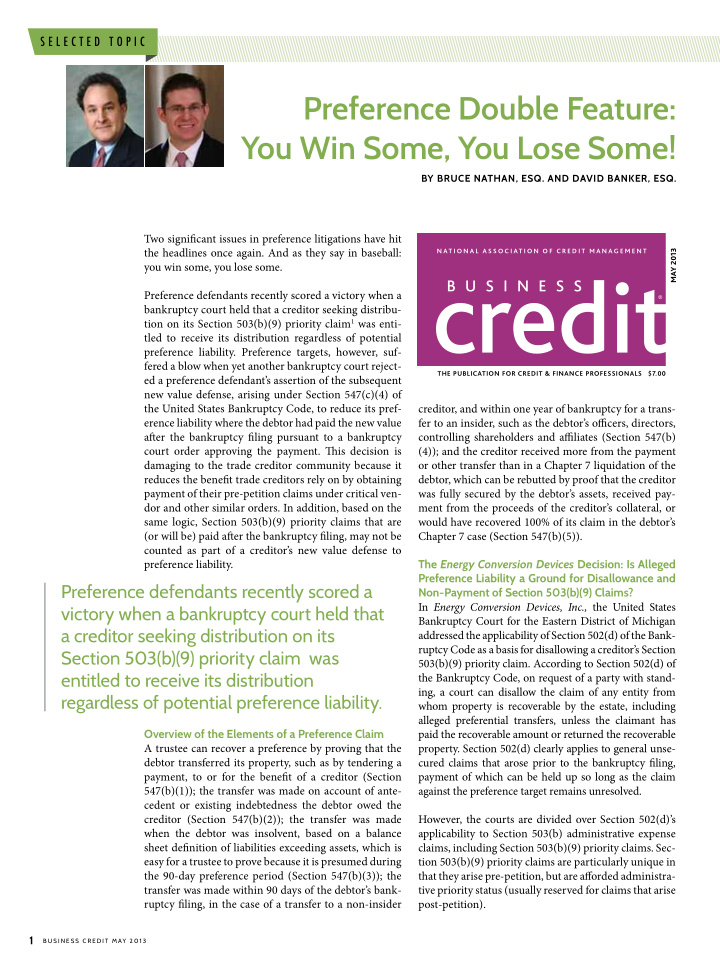



S e l e c t e d t o p i c Preference Double Feature: You Win Some, You Lose Some! by bruce NathaN, esq. aNd david baNker, esq. Two signifjcant issues in preference litigations have hit the headlines once again. And as they say in baseball: N AT I O N A L A S S O C I AT I O N O F C R E D I T M A N A G E M E N T MAY 2013 you win some, you lose some. Preference defendants recently scored a victory when a bankruptcy court held that a creditor seeking distribu- tion on its Section 503(b)(9) priority claim 1 was enti- tled to receive its distribution regardless of potential preference liability. Preference targets, however, suf- fered a blow when yet another bankruptcy court reject- THE PUBLICATION FOR CREDIT & FINANCE PROFESSIONALS $7.00 ed a preference defendant’s assertion of the subsequent new value defense, arising under Section 547(c)(4) of the United States Bankruptcy Code, to reduce its pref- creditor, and within one year of bankruptcy for a trans- erence liability where the debtor had paid the new value fer to an insider, such as the debtor’s offjcers, directors, afuer the bankruptcy fjling pursuant to a bankruptcy controlling shareholders and affjliates (Section 547(b) court order approving the payment. Tiis decision is (4)); and the creditor received more from the payment damaging to the trade creditor community because it or other transfer than in a Chapter 7 liquidation of the reduces the benefjt trade creditors rely on by obtaining debtor, which can be rebutted by proof that the creditor payment of their pre-petition claims under critical ven- was fully secured by the debtor’s assets, received pay- dor and other similar orders. In addition, based on the ment from the proceeds of the creditor’s collateral, or same logic, Section 503(b)(9) priority claims that are would have recovered 100% of its claim in the debtor’s (or will be) paid afuer the bankruptcy fjling, may not be Chapter 7 case (Section 547(b)(5)). counted as part of a creditor’s new value defense to preference liability. the Energy Conversion Devices decision: is alleged Preference Liability a Ground for disallowance and Preference defendants recently scored a Non-Payment of section 503(b)(9) claims? In Energy Conversion Devices, Inc., the United States victory when a bankruptcy court held that Bankruptcy Court for the Eastern District of Michigan a creditor seeking distribution on its addressed the applicability of Section 502(d) of the Bank- ruptcy Code as a basis for disallowing a creditor’s Section section 503(b)(9) priority claim was 503(b)(9) priority claim. According to Section 502(d) of entitled to receive its distribution the Bankruptcy Code, on request of a party with stand- ing, a court can disallow the claim of any entity from regardless of potential preference liability. whom property is recoverable by the estate, including alleged preferential transfers, unless the claimant has Overview of the elements of a Preference claim paid the recoverable amount or returned the recoverable A trustee can recover a preference by proving that the property. Section 502(d) clearly applies to general unse- debtor transferred its property, such as by tendering a cured claims that arose prior to the bankruptcy fjling, payment, to or for the benefjt of a creditor (Section payment of which can be held up so long as the claim 547(b)(1)); the transfer was made on account of ante- against the preference target remains unresolved. cedent or existing indebtedness the debtor owed the creditor (Section 547(b)(2)); the transfer was made However, the courts are divided over Section 502(d)’s when the debtor was insolvent, based on a balance applicability to Section 503(b) administrative expense sheet defjnition of liabilities exceeding assets, which is claims, including Section 503(b)(9) priority claims. Sec- easy for a trustee to prove because it is presumed during tion 503(b)(9) priority claims are particularly unique in the 90-day preference period (Section 547(b)(3)); the that they arise pre-petition, but are afgorded administra- transfer was made within 90 days of the debtor’s bank- tive priority status (usually reserved for claims that arise ruptcy fjling, in the case of a transfer to a non-insider post-petition). 1 B u s i n e s s C r e d i t m ay 2 0 1 3
Recommend
More recommend